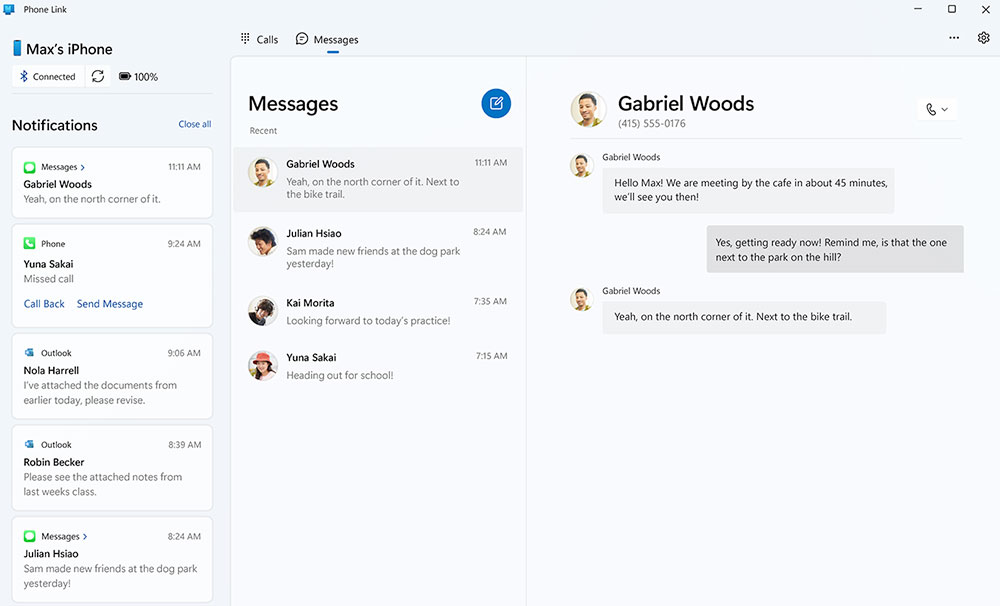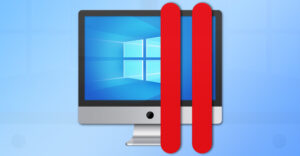Last week, I wrote about my longing for Windows users to have the same robust experience that macOS users have for accessing iMessage on their Mac devices. Intel’s Unison app, now available on select Intel Evo-certified laptops from HP, Lenovo, and Acer — and presumably more Windows laptops in the future — is a modest step in the right direction.
With that in mind, I had managed expectations for Microsoft’s updated Phone Link app, now available in preview build 22623.1325 of Windows 11. Unfortunately, Microsoft’s attempt to comprehend robust iPhone text messaging support in Windows is equally lackluster.
Microsoft formally provides access to iMessage on Windows using its Phone Link program. For Windows Insiders, a preview of the upgraded app is now possible. With the upgrade, the updated Phone Link app enables iPhone users to make and receive calls, send and receive messages using iMessage, and view their phone alerts inside Windows 11. The program also allows iPhone users to connect their handsets to a Windows laptop or PC.
What Is Phone Link?
Unlike the Intel Unison app, which users must download from the Windows App store on both their PC and iPhone, Phone Link is embedded in this new preview build of Windows 11. The app connects Windows machines to iPhones via Bluetooth, sending instructions and messages to the iMessage app.

Phone Link (Image Credit: Microsoft)
Sadly, Phone Link has the same limitations that plague the Intel Unison app. You can communicate with contacts who also own iPhones directly from your PC. However, you won’t be able to participate in group messages or send photographs in communications. PC users will see their iMessage discussions in a condensed form.
Limitations, Limitations, More Limitations
Only messages sent or received via Phone Link are shown in discussions, so you won’t be able to see the entire history of communications with another party. This Microsoft app cannot distinguish between a text message received via iMessage and a regular SMS message; Phone Link uses neither blue nor green bubbles, which is a significant text messaging experience concession versus using an iPhone with a macOS device.
Because Phone Link can only display photographs on your phone, the app lags far behind what’s possible when using a macOS device. The image limit is a paltry 2,000 of your recent pictures; neither video files nor albums are supported. Moreover, you cannot transfer files and images from your computer to the phone, and there is no way to transfer files from a phone to a computer. These limitations are almost laughable compared to using a macOS device with an iPhone.
On the Brighter Side
Microsoft has never enabled calls or messaging for iPhone users until now, and iPhone integration for Windows is still not comparable to what is offered for Android. In addition to being native, Phone Link is part of Windows 11, unlike previous PC link apps from Intel, Dell, and other companies, which provide a basic level of iPhone integration.
It seems that with Phone Link, Microsoft endeavors to provide the same positive Android phone experience that Windows users now have for iPhone users. In that regard, Microsoft’s heart seems to be in the right place, though its execution with Phone Link comes up short.
While Phone Link has no photo connectivity, I should point out that Microsoft’s Windows 11 Photos app already has iCloud Photos integration. Eventually, this capability could show up in Phone Link as well. In addition to this new Phone Link capability, other significant new features in the Windows 11 preview update include AI-powered Bing on the taskbar, a screen recording tool, and enhanced touch optimizations.
Microsoft started testing with a “limited number” of testers this week. If interested, you can try the new Phone Link functionality for iOS via the Dev, Beta, and Release Preview channels for Windows Insiders. The Windows team at Microsoft has indicated it will broaden the availability of the preview to additional Insiders over time and based on feedback the company gathers with this first set of Insiders.
Same Old Ecosystem Story
I’ve repeatedly mentioned this in previous analyses, but the lack of robust integration between the iPhone and Windows is a significant problem for the industry.
Solutions like Microsoft Phone Link, Intel Unison, and those from Dell and others are all workarounds that feel gimmicky and patchwork-like, especially for users who have played in Apple’s ecosystem for a limited time.
While I give Intel and Microsoft credit for trying to solve the problem, both companies’ hands are tied until Apple fully supports the iPhone in Windows.
With the overall PC market returning to its pre-pandemic flat (or even contracting) levels, coupled with perhaps recessionary conditions this year that will lengthen PC purchase cycles, this lack of genuine iPhone integration into the Windows ecosystem is a considerable headwind for both consumers and businesses.
Windows 11 High Points
Putting the iPhone integration topic aside, there’s a lot to like in Windows 11, which has morphed into a compelling alternative to macOS.
Compared to Windows 10 and earlier versions, Windows 11 offers faster startup times, better resource management, and improved laptop battery life. In the user interface area, Windows 11 has a redesigned UI with new animations and visual effects. It also introduces a new Start Menu design that places app icons in the center of the screen, which promises usability benefits.
Windows 11 also sports new productivity enhancements with a new feature called Snap Layouts, which allows users to position multiple apps side-by-side with predefined layouts.
A new virtual desktop feature in the latest Windows 11 enables users to create multiple desktops for different tasks and several new security features, such as a built-in ransomware protection tool, hardware-based isolation for sensitive processes, and improved security for remote work scenarios.
Finally, Windows 11 is designed to be backward-compatible (a historic Windows strength) with most Windows 10 applications and hardware.
While Windows’ iPhone integration deficiency doesn’t ultimately dilute the value proposition of Windows 11, iPhone integration is a missed opportunity for Microsoft that may never get resolved.
Cross-platform interoperability is a crucial element of the Apple ecosystem, and it’s hard to imagine any scenario where Apple offers those “keys to the kingdom” to Intel or Microsoft since there’s no business upside for Apple.
The losers, of course, are the millions of Windows users who own iPhones and have to sub-optimize their overall productivity.

























































